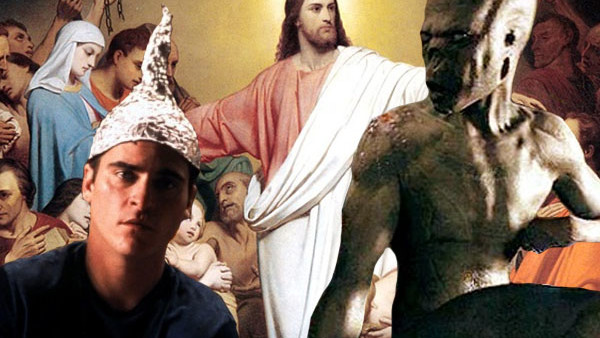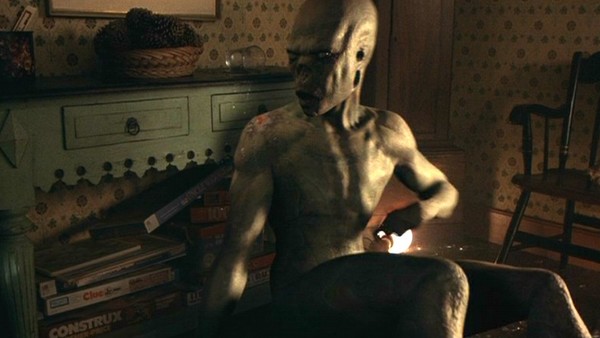Film Theory: The Aliens In Signs Aren't What They Seem...
Whether it's above the stars or the depths of hell, where exactly do these 'aliens' come from?

It’s only appropriate that an M. Night Shyamalan-sized twist can be applied to his own movie.
Coming out in 2002 to a mix of reviews, the alien invasion film Signs has both terrified and angered fans the world over, combining horrifying glimpses of extraterrestrial intruders with an ending that can only be described by the disrespectful few as... ill-conceived.
The film follows the Hess family as they experience strange happenings around their farmyard home linked to an upcoming alien invasion. Graham Hess has recently lost his wife in a car accident, and in turn, his Christian faith, retiring as a priest to instead become a farmer and raise his two children in privacy with help from his brother Merrill. Their privacy is soon turned against them however, as the invading forces break into their home - after which their one weakness is discovered and exploited in order to survive.
As those who have seen the movie already know, the one weakness of the interstellar force turns out to be plain old water. Which brings about the glaring question of why an alien race with advanced technology, intelligence, and the choice of any other location decide to come and visit the one place they could die with a bad weather forecast?
The answer lies in the film itself: the aliens have come for humans, not our planet, poisoning and kidnapping bodies across the globe before retreating back to the skies. But then what could they want with human hosts?
7. The Aliens Are An Allegory For Demons

It makes sense when at the heart of the narrative, Signs is about a religious man struggling to come to terms with his faith. After being rocked by the death of his wife Colleen at the hands of a traffic accident caused by veterinarian Ray Reddy asleep at the wheel, the Episcopal priest Graham Hess loses his faith in God - pushed to bitterness and regret through being unable to understand the wider motives of his God’s plan.
It’s around admitting his belief has died that Graham starts experiencing an alien presence in his life, or rather, on the other end of the spectrum: demons become interested in his vulnerable, eternal soul.
The first ‘sign’ that things might not be what the film presents them as comes in their timing, with Graham’s lost faith serving as a break down in his barriers of protection, allowing these demons to manifest in his home and across his property.
Whilst this knowledge was likely brewing in him for some time, these alien-demons arrive and appear more frequently with each refusal of his religious title, Father; culminating in an attack on the property in tandem with his outright refusal to pray at what would be considered the family’s ‘last supper’.
Before we get ahead of ourselves, however, we can trace this religious influence over the scientific events of the movie from the very opening scene. Graham’s daughter Bo’s first words ask her father if “he’s in her dream too,” blowing the movie wide open for events that function as interpretive rather than realistic.
If we really are experiencing a dream-world, whether explicitly stated or not, then every action and reaction becomes an exercise in reading between the lines - a subconscious reflection of Graham’s own insecurities in his seemingly ‘waking’ moments.
6. Hell Is A Place On Earth

We then hear his son Morgan state upon seeing the crop circle that starts it all: “I think God did it.” We’re instantly introduced to the duplicitous tone of the film, whether what we’re seeing is a warning from the heavens, or if rationality and science are the only truth out in the cold reaches of the unknown.
Yes, it shoe-horns in that we’re dealing with a religious family, but it also is the best example of the famous ‘God working in mysterious ways,’ namely dropping a strange symbol into the middle of their food supply that functions as ‘the mark of the beast’, drawing the hellish forces right to their doorstep. It’s even shaped remotely like a pitch fork, in reference to the typical stylised weapon of old school demons.
There’s more than one reference to suffering in hell at the hands of these ‘aliens’, also, with the barbeque of the early moments of the film bringing about connotations of burning and death - especially when the fork is used to kill their dog Houdini. Transformed from the placid family pet into a viscous, hungry beast, it can be argued that the dog becomes a hellhound - a minion of the devil - in the presence of demonic influences taking root in the farmyard home.
Later in the film, we’re also very directly lead to look at the image of a typical spaceship burning down a farm house almost identical to the Hess family home. It’s the most obvious offering of a link between these so called ‘aliens’ (cough, demons) and hell, coming from a book of information that Morgan informs us was written by “scientists who had been persecuted for their beliefs.”
Sound familiar? Perhaps it rings some bells when we take a look at the bible, a similar tome of collective authors who have been killed, shunned, or laughed at in their passionate dedication to Christianity.